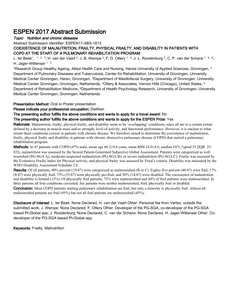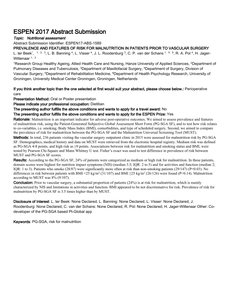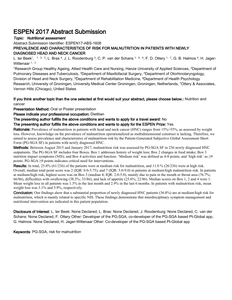Objectives: Malnutrition is associated with a twofold higher risk of dying in patients with tuberculosis (TB) and considered an important potentially reversible risk factor for failure of TB treatment. The construct of malnutrition has three domains: intake or uptake of nutrition; body composition and physical and cognitive function. The objectives of this systematic review are to identify malnutrition assessment methods, and to quantify how malnutrition assessment methods capture the international consensus definition for malnutrition, in patients with TB.Design: Different assessment methods were identified. We determined the extent of capturing of the three domains of malnutrition, that is, intake or uptake of nutrition, body composition and physical and cognitive function.Results: Seventeen malnutrition assessment methods were identified in 69 included studies. In 53/69 (77%) of studies, body mass index was used as the only malnutrition assessment method. Three out of 69 studies (4%) used a method that captured all three domains of malnutrition.Conclusions: Our study focused on published articles. Implementation of new criteria takes time, which may take longer than the period covered by this review. Most patients with TB are assessed for only one aspect of the conceptual definition of malnutrition. The use of international consensus criteria is recommended to establish uniform diagnostics and treatment of malnutrition.
LINK
Background: Urban slums are characterised by unique challenging living conditions, which increase their inhabitants’ vulnerability to specific health conditions. The identification and prioritization of the key health issues occurring in these settings is essential for the development of programmes that aim to enhance the health of local slum communities effectively. As such, the present study sought to identify and prioritise the key health issues occurring in urban slums, with a focus on the perceptions of health professionals and community workers, in the rapidly growing city of Bangalore, India. Methods: The study followed a two-phased mixed methods design. During Phase I of the study, a total of 60 health conditions belonging to four major categories: - 1) non-communicable diseases; 2) infectious diseases; 3) maternal and women’s reproductive health; and 4) child health - were identified through a systematic literature review and semi-structured interviews conducted with health professionals and other relevant stakeholders with experience working with urban slum communities in Bangalore. In Phase II, the health issues were prioritised based on four criteria through a consensus workshop conducted in Bangalore. Results: The top health issues prioritized during the workshop were: diabetes and hypertension (non-communicable diseases category), dengue fever (infectious diseases category), malnutrition and anaemia (child health, and maternal and women’s reproductive health categories). Diarrhoea was also selected as a top priority in children. These health issues were in line with national and international reports that listed them as top causes of mortality and major contributors to the burden of diseases in India. Conclusions: The results of this study will be used to inform the development of technologies and the design of interventions to improve the health outcomes of local communities. Identification of priority health issues in the slums of other regions of India, and in other low and lower middle-income countries, is recommended.
DOCUMENT

The aim of this study, is to assess changes in prevalence and frailty score during pulmonary rehabilitation (PR) in patients with COPD.
DOCUMENT

Rationale: Currently use of muscle thickness measured with ultrasound is suggested as an indicator for overall muscle mass in nutritional assessment. However, not much is known about how the muscle thickness measured in patients with chronic obstructive pulmonary disease (COPD) compares to the muscle thickness in healthy persons. This study explores body mass index (BMI) and rectus femoris (RF) muscle thickness in patients with advanced COPD matched with healthy controls. Methods: Patients with advanced COPD at the start of a pulmonary rehabilitation program were matched for age (5 years difference tolerance), sex (exact match), and stature (0.1 m difference tolerance) with healthy controls in a 1:4 case control ratio. BMI (kg/m2) was calculated and muscle thickness (mm) of the RF was measured with a Bodymetrix device. Paired sample t-tests were performed. BMI and RF muscle thickness of the cases were paired with the average BMI and RF of their controls. A p-level of <0.05 was considered significant and 95% CI were presented for the mean difference. Results: In total, 21 cases (median GOLD score 3 [interquartile range 3-4]; age 64.5±6.4y; female 62%; height 1.68±0.07m; BMI 26.9±6.1 kg/m2; RF 12.4±3.4mm) and 84 controls (age 64.5±6.4y; female 62%; height 1.71±0.09 m; BMI 25.8±4.5; RF 14.6±4.5mm) were included in the analyses. In the paired test, BMI was not significantly different between cases and controls (p=0.645, mean difference 0.95 kg/m2 [CI:-2.12 – 4.01]), whereas RF muscle thickness of cases was significantly lower (p=0.003, mean difference -2.33 mm [CI:-3.73 - -0.92]). Conclusion: In this limited sample of patients with COPD, RF muscle thickness in cases was significantly lower than RF muscle thickness in matched controls. Research in bigger samples is needed to confirm whether RF muscle thickness measured with US provides more useful information about body composition for clinicians than BMI in patients with COPD.
DOCUMENT
Rationale: Malnutrition is a common problem in patients with Chronic Obstructive Pulmonary Disease (COPD). Whereas estimation of fat-free muscle mass index (FFMi) with bio-electrical impedance is often used, less is known about muscle thickness measured with ultrasound (US) as a parameter for malnutrition. Moreover, it has been suggested that in this population, loss of muscle mass is characterized by loss of the lower body muscles rather than of the upper body muscles.1 Therefore, we explored the association between FFMi, muscle thickness of the biceps brachii (BB) and the rectus femoris (RF), and malnutrition in patients with COPD. Methods: Patients were assessed at the start of a pulmonary rehabilitation program. Malnutrition was assessed with the Scored Patient-Generated Subjective Global Assessment (PG-SGA). Malnutrition was defined as PG-SGA Stage B or C. FFMi (kg/m²) was estimated with bio-electrical impedance analysis BIA 101® (Akern), using the Rutten equation. Muscle thickness (mm) of the BB and the RF was measured with the handheld BodyMetrix® device (Intelametrix). Univariate and multivariate logistic regression analyses were performed to analyse associations between FFMi and muscle thickness for BB and RF, and malnutrition. Multivariate analysis corrected for sex, age, and GOLD-stage. Odds ratios (OR) and 95% confidence intervals (CI) were presented. A p-level of <0.05 was considered significant. Results: In total, 27 COPD patients (age 64±8.1 years; female 60%, GOLD-stage 3, interquartile range=3-4, BMI 27±6.6 kg/m2) were included in the analyses. In the univariate analysis, FFMi (p=0.014; OR=0.70, 95%CI: -0.12—0.15), RF thickness (p=0.021; OR=0.79, 95%CI: -0.09—0.01), and BB thickness (p=0.006; OR=0.83, 95%CI: -0.06—0.01) were all significantly associated with malnutrition. In the multivariate analysis, FFMi (p=0.031; OR=0.59, 95%CI: -0.18—0.01) and BB thickness (p=0.017; OR=0.73, 95%CI:-0.09—0.01) were significantly associated with malnutrition. None of the co-variables were significantly associated with malnutrition. Conclusion: In this relatively small sample of patients with severe COPD, low FFMi and low BB muscle thickness were both robustly associated with increased odds of being malnourished. BB muscle thickness measured with US may provide added value to the toolbox for nutritional assessment. The results of this exploratory study suggest that upper body muscles may reflect nutritional status more closely than lower body muscles. Reference: 1 Shrikrishna D, Patel M, Tanner RJ, Seymour JM, Connolly BA, Puthucheary ZA, et al. Quadriceps wasting and physical inactivity in patients with COPD. Eur Respir J. 2012;40(5):1115–22.)
DOCUMENT

DOCUMENT

DOCUMENT

DOCUMENT
